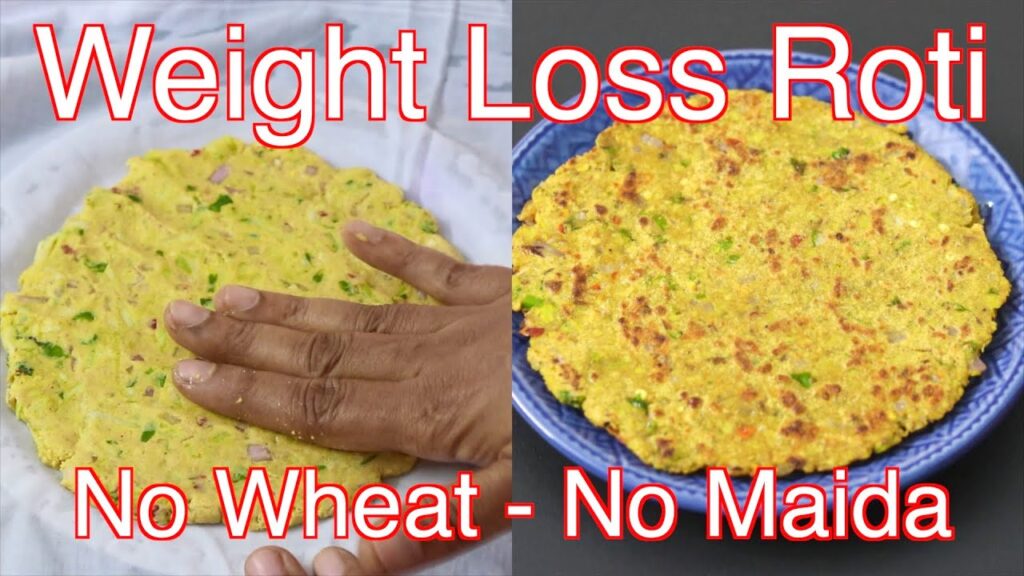Healthy Weight-Loss Roti Recipe – No Atta No Maida

Introduction
Healthy Weight-Loss Roti Recipe – No Atta No Maida, In the quest for a healthier lifestyle and managing weight, dietary choices play a pivotal role. One staple food that holds significant importance in many cultures is roti, a traditional flatbread. Often made using wheat flour (atta) or refined flour (maida), traditional rotis can be calorie-dense and may not align well with weight loss goals. However, a healthier alternative has emerged – a weight-loss roti recipe that skips both atta and maida, offering a nourishing and satisfying option for those seeking a healthier way to enjoy this essential food item.
The Shift from Atta and Maida

Atta and maida, commonly used flours for making rotis, can contribute to higher calorie intake and might lead to fluctuations in blood sugar levels due to their high carbohydrate content. This can be problematic for individuals looking to lose weight or manage their blood sugar. In the pursuit of a healthier lifestyle, the switch to alternative flours becomes crucial.
Ingredients You’ll Need
- 1 cup chickpea flour (besan): Chickpea flour is a great source of protein, dietary fiber, and essential minerals.
- 1/4 cup flaxseed meal: Flaxseeds are rich in omega-3 fatty acids and provide a good dose of fiber.
- 1/4 cup grated vegetables: Opt for nutrient-packed vegetables like spinach, carrots, or zucchini.
- Spices: Turmeric, cumin, coriander, and ajwain (carom seeds) can be added for flavor and health benefits.
- Water: To make a smooth and consistent dough.
- Salt: To taste.
Instructions
- Mix the Dry Ingredients: In a mixing bowl, combine chickpea flour, flaxseed meal, grated vegetables, spices, and a pinch of salt. These ingredients will form the base of your roti dough.
- Gradually Add Water: Begin adding water slowly and gradually while kneading the mixture. The goal is to create a soft, pliable dough. Be cautious not to make it too sticky or too dry.
- Rest the Dough: Cover the dough and let it rest for about 15-20 minutes. This allows the flour to absorb moisture, making the dough easier to work with.
- Divide and Roll: Divide the dough into small portions. Take one portion, roll it into a ball, and then flatten it slightly between your palms.
- Rolling the Roti: Place the dough ball on a flat, clean surface. You can use parchment paper or a silicon baking mat to prevent sticking. Using a rolling pin, gently roll out the dough ball into a thin, round roti.
- Cooking the Roti: Heat a non-stick skillet or tawa over medium heat. Place the rolled roti on the skillet and cook until small bubbles form on the surface. Flip the roti and cook the other side until light golden spots appear.
- Healthy Alternatives: Instead of using oil or ghee, you can lightly brush the roti with olive oil or clarified butter (ghee) for added flavor and health benefits.
- Serve Warm: Once cooked, remove the roti from the skillet and serve it warm with your choice of healthy sides like yogurt, vegetables, or lean proteins.
The Benefits

This innovative weight-loss roti recipe offers a multitude of benefits:
- Low Carb and High Protein: Chickpea flour is lower in carbohydrates compared to wheat flour, and it provides a good dose of plant-based protein.
- Rich in Fiber and Healthy Fats: Flaxseed meal contributes to the overall fiber content, aiding digestion and promoting a feeling of fullness. Omega-3 fatty acids in flaxseeds support heart and brain health.
- Vegetable Boost: Incorporating grated vegetables not only adds flavor and texture but also introduces a range of vitamins, minerals, and antioxidants to your meal.
- Blood Sugar Regulation: The combination of chickpea flour, flaxseeds, and vegetables helps regulate blood sugar levels, making this roti suitable for individuals with diabetes or those aiming for balanced blood sugar.
- Satiety and Weight Management: The protein, fiber, and healthy fats in this roti contribute to satiety, aiding weight management efforts.
FAQs
1. What is the main flour used in this healthy roti recipe?
The main flour used in this recipe is chickpea flour, also known as besan. Chickpea flour is a protein-rich and lower-carb alternative to traditional wheat flour.
2. Can I use other flour instead of chickpea flour?
While chickpea flour is the primary ingredient in this recipe, you can experiment with other alternative flour like almond flour, coconut flour, or quinoa flour. Each flour may have different properties, so adjustments might be needed.
3. Why is a flaxseed meal included in the recipe?
Flaxseed meal is added to increase the fiber and healthy fat content of the roti. It promotes satiety, aids digestion, and provides essential omega-3 fatty acids.
4. Can I skip the vegetables in the recipe?
While vegetables are an important part of the recipe, you can adjust the quantity or type based on your preference. Including vegetables enhances the nutritional content and adds flavor.
5. How do these rotis help with weight loss?
These rotis are designed to be lower in carbohydrates, higher in protein and fiber, and nutrient-dense. These qualities contribute to a feeling of fullness, which can aid in weight management by reducing overeating.
Conclusion
Healthy Weight-Loss Roti Recipe – No Atta No Maida, With a shift away from conventional flours like atta and maida, this healthy weight-loss roti recipe showcases how simple modifications can lead to a more nutritious and waistline-friendly option. By focusing on nutrient-dense ingredients like chickpea flour, flaxseeds, and vegetables, you can enjoy the satisfaction of a well-rounded meal while aligning with your weight loss and overall health goals. Remember, small changes in your diet can lead to significant positive impacts on your well-being.







